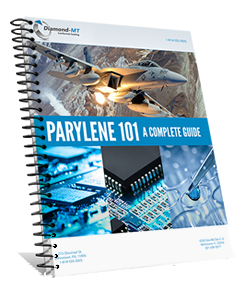
Parylene conformal coating is becoming an ever increasing part of everyday life for the defense, bio-medical, and other industries. Download Diamond-MT’s Parylene 101: Coating Facts Sheet to understand the basic facts on the process.
Learn about:
- The parylene deposition process
- What is parylene dimer?
- Differences between parylene C, parylene N, parylene D, and parylene F
- The main benefits of parylene
- Common applications of parylene
Parylene Conformal Coating
Parylene is considered by many to be the ultimate conformal coating for protection of devices, components and surfaces in electronics, instrumentation, aerospace, medical and engineering industries. Parylene is unique in being created directly on the surface at room temperature. It is chemically stable and makes an excellent barrier material, has excellent thermal endurance, as well as excellent mechanical properties and high tensile strength.
- There is no liquid phase involved. Coatings are truly conformal, of uniform controllable thickness, and are completely pinhole-free at thicknesses greater than 0.5µ.
- Parylene coating completely penetrates spaces as narrow 0.01mm.
- No initiators or catalysts are involved in the polymerization, so the coating is very pure and free from trace ionic impurities.
- Room temperature formation means the coatings are effectively stress-free.
- Parylene is chemically and biologically inert and stable and make excellent barrier material.
- Parylene is unaffected by solvents, have low bulk permeability and are hydrophobic. Coatings easily pass a 100hr salt-spray test.
- Parylene has excellent electrical properties: low dielectric constant and loss with good high-frequency properties; good dielectric strength; and high bulk and surface resistance.
- Parylene has good thermal endurance: Parylene C performs in air without significant loss of physical properties for 10 years at 80°C and in the absence of oxygen to temperatures in excess of 200°C.
- Parylene is transparent and can be used to coat optical elements.
- FDA approval of parylene-coated devices is well-documented. The coatings comply with USP Class VI Plastics requirements and are MIL-I-46058C / IPC-CC-830B listed.
- Parylene coatings are completely conformal, have a uniform thickness and are pinhole free. This is achieved by a unique vapor deposition polymerization process in which the coating is formed from a gaseous monomer without and intermediate liquid stage. As a result, component configurations with sharp edges, points, flat surfaces, crevices or exposed internal surfaces are coated uniformly without voids.
- Parylene coating provides an excellent barrier that exhibits a very low permeability to moisture and gases.
- Parylene coating has excellent mechanical properties, including high tensile strength.
- Parylene is stable over a very wide temperature range (-200 ‘C to +200 ‘C), allowing the chamber items coated in Parylene to be put in an autoclave.

Parylene Coating Applications
Here is a brief list of some of the items that can be parylene coated:
| Printed Circuit Boards | MEMs | LEDs |
| Catheters | Stents | Magnets |
| Paper | Needles | Sensors |
| Ferrite Cores | Metallic Blocks | Optical lenses |
| Implantable devices | Valves | O-rings |
| Tubing | Silicon Wafers | Keypads |
| Stoppers | Seals | Mandrels |
| Molds | Motor Assemblies | Power Supplies |
| Backplanes | Photoelectric Cells | Forceps |
| Test Tubes | Probes | Fiber Optic Components |
| Pace-makers | Bobbins | Plus Many More… |
Diamond MT – Our Parylene Process
Our process is clear and straightforward, ensuring the best possible end product.
Planning
Since our beginning, Diamond MT has established a reputation for providing the highest quality services in the industry. Our commitment to quality, integrity and customer satisfaction combined with an unmatched expertise in applications and processes has provided every one of our customers with superior results. Diamond MT’s quality manual ensures every employee is focused on continuous improvement and service excellence.
Development
Diamond MT understands and realizes that often times conformal coating is overlooked due to the fact that it is the last step in the process. We are committed to serving the industry with rapid turn times for parylene, (normally 10 business days) with expedited service in as little as 2-5 business days depending upon the complexity and quantity.
Production
Diamond MT operates out of a freestanding 12,000 square foot building located 60 miles southeast of Pittsburgh. Diamond MT is located near three major interstates and is supported by the Cambria County Airport, which serves as a primary freight terminal for south central Pennsylvania. Diamond MT maintains a strict program per NSI ANSI Standard 20.20 for ESD protection.

